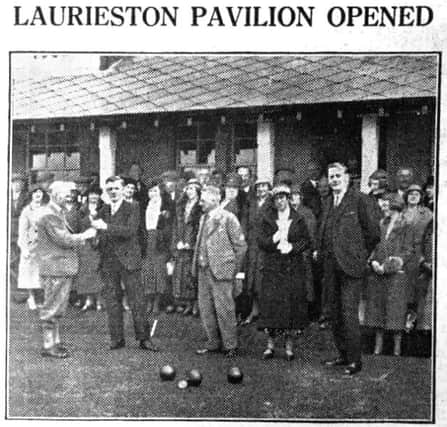Village was bowled over by James' enthusiasm!


Despite the temptation of so many other activities, bowling remains one of the country’s most popular participation sports with thousands of people of all ages taking part on local greens which often date back to the early 1800s.
In our area it was the growing population and prosperity in the 19th century that brought the rapid spread of the game.
Advertisement
Hide AdAdvertisement
Hide AdIn those early days it was usually ‘‘professional and business men’’ who banded together to create the first bowling clubs long before golf or football had places of their own.
In the book Peter Alexander takes us back to the period before World War 1 when the leading men of the village first raised the possibility of a green for Laurieston.
Most other corners of Falkirk district had already taken the plunge but, as Peter says, the village had “no Carnegies in its midst” with lots of cash ready to fund the purchase of land and preparation of a green.
If Laurieston wanted a bowling green it would have to raise the money and that is what the committee formed in 1913 proceeded to do.
Advertisement
Hide AdAdvertisement
Hide AdA number of fund raising activities followed including a three day bazaar, a jumble sale, band concerts and prize draws.
A great fete took place in Callendar Park with all manner of games and entertainments.
These included “a triple man hunt” which was won by a miner who was said to be on strike at the time!
A shooting competition offered prizes such as “a cockerel and a razor in a case” and a local farmer offered a calf for auction at the Falkirk mart which raised a substantial sum!
Advertisement
Hide AdAdvertisement
Hide AdDriving the project forward was Mr James H Mather, one of Falkirk district’s most famous men.
He was headmaster of the village school for 28 years and held many posts of importance.
Famously he maintained contact with his ex-pupils who were fighting in the war and compiled a scrapbook of photographs and cuttings relating to each boy. This is now in the archives at Callendar House.
The fundraising was a slow process with so many post war demands on limited resources but by 1920 there was enough in the kitty to purchase three-quarters of an acre of land where the green stands today.
Advertisement
Hide AdAdvertisement
Hide AdOne of the conditions of the sale was that a properly constituted Bowling Club was established and on July 23 this was completed with 29 members paying the half crown subscription. James Mather was elected the first and, as it turned out, the longest serving president.
Back in 1914 the Falkirk Mail commented on the proposals as follows: “In the beauty of the summer months what better recreation can be imagined for both young and old than a quiet and pleasant game of bowls? Laurieston is hopeful of enjoying that luxury before many months have passed.”
Peter Alexander’s book describes the many highlights of the century that followed.
It is well illustrated and will be of great interest to bowlers, villagers and local historians.
Advertisement
Hide AdAdvertisement
Hide AdIt is available from the club or directly from Peter on 07966 305324 or at [email protected].
The modest price is a suggested donation of £3.50 all of which will go to support the junior section which will help to ensure the continuation of the story which began in the shadow of the Great War 100 years ago.